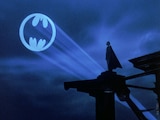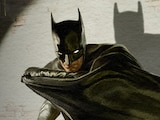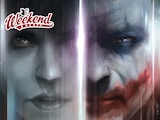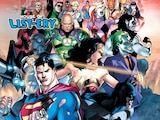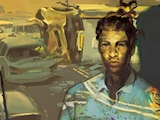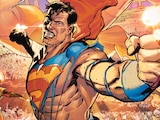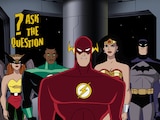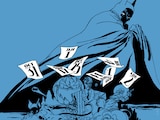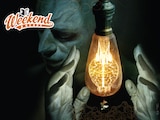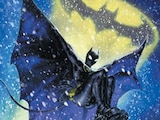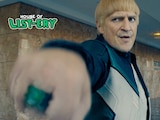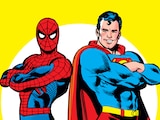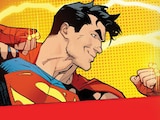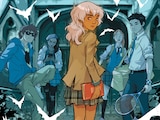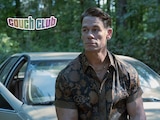Yesterday you got a chance to look at the rhythmic and riveting beginning of Selwyn's proposal for DOMINIQUE LAVEAU: VOODOO CHILD-- the third new series this March of mystery and madness here at Vertigo! As I'm sure you could tell, Selwyn's pitch had a special something just from the opening couple of paragraphs. He immediately illuminated the high concept of the series, establishing Dom, her situation, her world in New Orleans just a few months after Hurricane Katrina, and the dark magic beyond that everyday reality-- the secret, yet powerful Voodoo Court, their influence into both the mortal and supernatural worlds-- and ultimately Dom's role in all this. (Whew--that was a long sentence!)As promised, today you're going to hear a bit more about the man behind this incredible new myth but before you hear from Selwyn Seyfu Hinds himself, a brief intro…
A music journalist to start (his first writing gig was at the Village Voice), Selwyn was editor-in-chief of The Source magazine in the late 90s, a documentary producer, most notably at BET where he was in charge of the network's coverage of Hurricane Katrina and the 2008 Presidential election, and the author of two books, Gunshots in my Cook-up (best title ever!) and To a Young Jazz Musician: Letters from the Road, written with the amazing Wynton Marsalis. Selwyn is also a longtime DJ and self-professed sci-fi and comics nerd-- with LUCIFER by Mike Carey and Peter Gross being one of his favorite series. What a perfect segue-way to the following interview with Selwyn conducted by assistant editor Joe Hughes. Enjoy!
Voodoo mythology, historically, doesn't get the same amount of attention as many other cultural folklore. When you started research for Voodoo Child, was a lot of this new to you, or was this a topic you were well versed in long before?
I’ve always had a hankering for occult and supernatural lore, especially those forms with Caribbean origins. So I had more than a passing familiarity with Voodoo. Even then, the popular tropes about the mythology—the dolls, the needles, zombies in Haiti— still took up too much space in my mental hard drive. I had to dump most of that to make room for everything I found in my research, which focused heavily on the Voodoo pantheon, and on the particulars of the form as practiced in 19th-century New Orleans. Of course, once I had that baseline, I took full literary license with the mythology to develop the series.
It's no secret that there's a dearth of female representation in comics, but that's especially true when it comes to women of color. Was this something you were always conscious of as you were coming up with a series for Vertigo?
Certainly. As writers, the DNA of the worlds we imagine draws in no small part from the worlds we actually see. And the worlds I see contain all kinds of people—across gender, race, sexuality, what have you. Why wouldn’t you want to take advantage of that kind of potential narrative richness? In terms of Dominique, I didn’t set out saying my series had to be fronted by a woman of color. But I knew whatever idea I came up with, the characters had to be organic to the milieu. And once I’d zeroed in on New Orleans and conceptualized this notion of a Court-like structure as a hidden power in the city, Voodoo Queens made a lot more sense than Voodoo Kings! From that point, Dominique practically wrote herself. She was an organic creation.
New Orleans is the setting for your story, but it feels like it's a character in the series as well. How does the city itself play a role in the story?
Character is place. So when I was figuring out what kind of series to write, the very first box I checked was that the series had to be grounded in a city. It had to feel rooted and informed by place. Thus, New Orleans was my first character. Everything else flows from it, whether it's my take on Voodoo mythology, the jazz and blues-influenced narrative style, or the characters that populate the series. Not to mention the mood, tone, and overall look of the book. And, of course, the storylines tie into the city. For instance, while this series isn’t specifically about Katrina or its aftermath, that event is a metaphorical (and sometimes literal) ghost that casts a shadow over events. “Real” New Orleans will weave in and out in many other ways. In the end, the ethereal elements of the series only work because they’re anchored and balanced by the real elements.
Tell us why people are going to love Dominique as a character.
I think there’s something deeply empathetic about Dominique and the journey she takes. Beneath all the fantastical trappings, fictional characters work because we as readers buy into them as people. We find common cause with their humanity, their motivations. Dominique’s a young woman whose life is violently ripped apart, causing her to set off on a fraught journey that takes her from outcast to acceptance. Who among us hasn’t experienced the turmoil of a life-shaking event, or battled in our own ways to live life on our terms? I think we can all recognize something in Dominique. And I believe the very human grace with which she conducts her quest, especially when it’s most stark, will resonate with the reader. Clearly, I fell hard for this character, and I hope everyone else will, too.
Did you have anyone in mind when you created her?
No one person in particular. Most times when I’m creating something new I surround myself with as much relevant and evocative media as possible—music, pictures, and so forth. In the early days of writing Dominique, I listened to a lot of Nina Simone and Ella Fitzgerald, and I’d keep lots of reference images on my computer screen, including Linda Hamilton as Sarah Connor, Pam Grier in the movie poster for Coffy, Zoe Saldana in Colombiana, and paintings of the real Marie Laveau. There’s probably a bit of all of them in Dominique.
What's your favorite page from issue #1?
I love everything Denys and John did, but the double spread on 12/13 never fails to knock me over. I’d spent all this time in the script painstakingly describing this moment where Dominique’s spirit is hurled somewhere else, even as she’s physically falling into a grave, and how our perception of the time progression for “spirit” Dom and “falling” Dom had to be completely different. Then Denys basically said, “How ‘bout this?” And the results took what I’d envisioned and exploded it, exponentially. The spread confirmed that we were really going on a wild ride. And that’s definitely held true for me.
Tomorrow: We spill the beans on Denys Cowan, artist extraordinaire, and co-creator!
I can't wait!See you then--
Karen Berger

